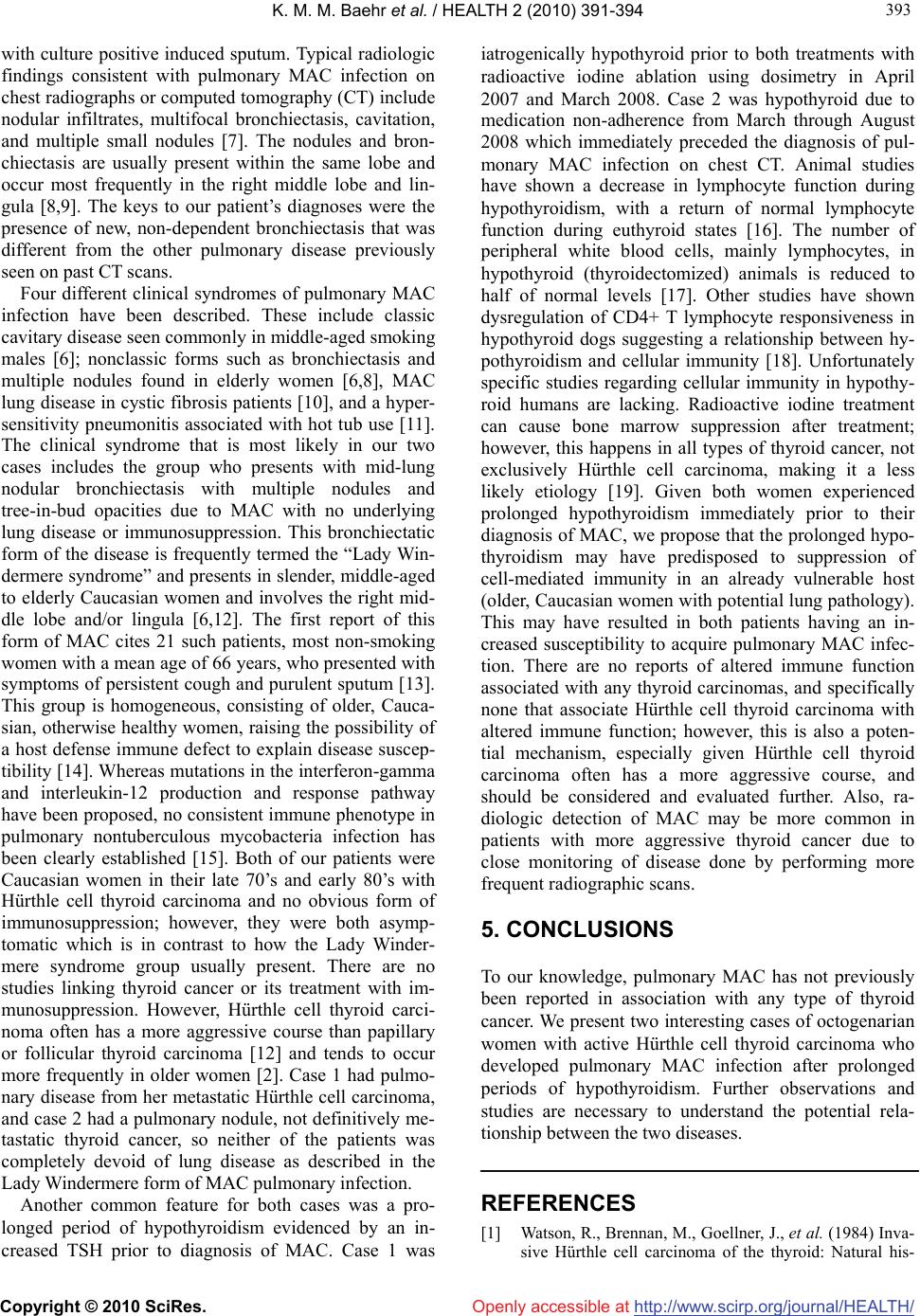
K. M. M. Baehr et al. / HEALTH 2 (2010) 391-394
Copyright © 2010 SciRes. Openly accessible at http://www. scirp.org/journal/HEALTH/
393
393
with culture positive induced sputum. Typical radiologic
findings consistent with pulmonary MAC infection on
chest radiographs or computed tomography (CT) include
nodular infiltrates, multifocal bronchiectasis, cavitation,
and multiple small nodules [7]. The nodules and bron-
chiectasis are usually present within the same lobe and
occur most frequently in the right middle lobe and lin-
gula [8,9]. The keys to our patient’s diagnoses were the
presence of new, non-dependent bronchiectasis that was
different from the other pulmonary disease previously
seen on past CT scans.
Four different clinical syndromes of pulmonary MAC
infection have been described. These include classic
cavitary disease seen commonly in middle-aged smoking
males [6]; nonclassic forms such as bronchiectasis and
multiple nodules found in elderly women [6,8], MAC
lung disease in cystic fibrosis patients [10], and a hyper-
sensitivity pneumonitis associated with hot tub use [11].
The clinical syndrome that is most likely in our two
cases includes the group who presents with mid-lung
nodular bronchiectasis with multiple nodules and
tree-in-bud opacities due to MAC with no underlying
lung disease or immunosuppression. This bronchiectatic
form of the disease is frequently termed the “Lady Win-
dermere syndrome” and presents in slender, middle-aged
to elderly Caucasian women and involves the right mid-
dle lobe and/or lingula [6,12]. The first report of this
form of MAC cites 21 such patients, most non-smoking
women with a mean age of 66 years, who presented with
symptoms of persistent cough and purulent sputum [13].
This group is homogeneous, consisting of older, Cauca-
sian, otherwise healthy women, raising the possibility of
a host defense immune defect to explain disease suscep-
tibility [14]. Whereas mutations in the interferon-gamma
and interleukin-12 production and response pathway
have been proposed, no consistent immune phenotype in
pulmonary nontuberculous mycobacteria infection has
been clearly established [15]. Both of our patients were
Caucasian women in their late 70’s and early 80’s with
Hürthle cell thyroid carcinoma and no obvious form of
immunosuppression; however, they were both asymp-
tomatic which is in contrast to how the Lady Winder-
mere syndrome group usually present. There are no
studies linking thyroid cancer or its treatment with im-
munosuppression. However, Hürthle cell thyroid carci-
noma often has a more aggressive course than papillary
or follicular thyroid carcinoma [12] and tends to occur
more frequently in older women [2]. Case 1 had pulmo-
nary disease from her metastatic Hürthle cell carcinoma,
and case 2 had a pulmonary nodule, not definitively me-
tastatic thyroid cancer, so neither of the patients was
completely devoid of lung disease as described in the
Lady Windermere form of MAC pulmonary infection.
Another common feature for both cases was a pro-
longed period of hypothyroidism evidenced by an in-
creased TSH prior to diagnosis of MAC. Case 1 was
iatrogenically hypothyroid prior to both treatments with
radioactive iodine ablation using dosimetry in April
2007 and March 2008. Case 2 was hypothyroid due to
medication non-adherence from March through August
2008 which immediately preceded the diagnosis of pul-
monary MAC infection on chest CT. Animal studies
have shown a decrease in lymphocyte function during
hypothyroidism, with a return of normal lymphocyte
function during euthyroid states [16]. The number of
peripheral white blood cells, mainly lymphocytes, in
hypothyroid (thyroidectomized) animals is reduced to
half of normal levels [17]. Other studies have shown
dysregulation of CD4+ T lymphocyte responsiveness in
hypothyroid dogs suggesting a relationship between hy-
pothyroidism and cellular immunity [18]. Unfortunately
specific studies regarding cellular immunity in hypothy-
roid humans are lacking. Radioactive iodine treatment
can cause bone marrow suppression after treatment;
however, this happens in all types of thyroid cancer, not
exclusively Hürthle cell carcinoma, making it a less
likely etiology [19]. Given both women experienced
prolonged hypothyroidism immediately prior to their
diagnosis of MAC, we propose that the prolonged hypo-
thyroidism may have predisposed to suppression of
cell-mediated immunity in an already vulnerable host
(older, Caucasian women with potential lung pathology).
This may have resulted in both patients having an in-
creased susceptibility to acquire pulmonary MAC infec-
tion. There are no reports of altered immune function
associated with any thyroid carcinomas, and specifically
none that associate Hürthle cell thyroid carcinoma with
altered immune function; however, this is also a poten-
tial mechanism, especially given Hürthle cell thyroid
carcinoma often has a more aggressive course, and
should be considered and evaluated further. Also, ra-
diologic detection of MAC may be more common in
patients with more aggressive thyroid cancer due to
close monitoring of disease done by performing more
frequent radiographic scans.
5. CONCLUSIONS
To our knowledge, pulmonary MAC has not previously
been reported in association with any type of thyroid
cancer. We present two interesting cases of octogenarian
women with active Hürthle cell thyroid carcinoma who
developed pulmonary MAC infection after prolonged
periods of hypothyroidism. Further observations and
studies are necessary to understand the potential rela-
tionship between the two diseases.
REFERENCES
[1] Watson, R., Brennan, M., Goellner, J., et al. (1984) Inva-
sive Hürthle cell carcinoma of the thyroid: Natural his-